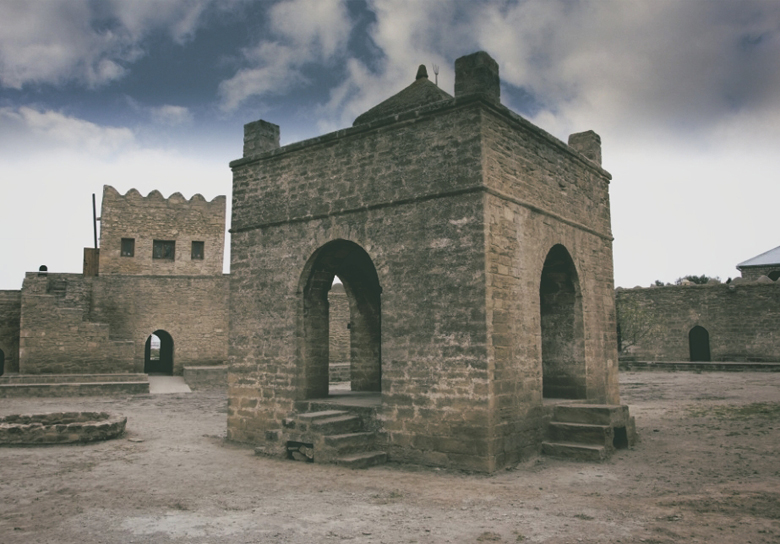Ateshgah is a temple of fire in Azerbaijan, on the Absheron peninsula, 30 km from the center of Baku, on the outskirts of the village of Surahani in the Surahan region, at various times revered by Zoroastrians, Hindus and Sikhs. It arose in the XVII — XVIII centuries. in place of the “eternal” unquenchable fires – burning outlets of natural gas , due to which the temple is called “Ateshgah”, which means “House of Fire”, “Place of Fire”
It is believed that the seven liturgical fires of the 7th century BCE refer to an Armenian geography. The invasion of the Kasarites in 730 BCE is attributed to the place “Atsi Bhagwan”, which is believed to have been a famous python. Since the word “Bhaga” refers to God in the tradition and the word “Bhagavan” in the Sangam, “Atsi Bhagavan” can be the place where “Agni Bhagavan” or “Fire of God” is worshiped. Esudakiri, an Iranian traveler who lived in the tenth century, says firefighters live very close to Baku.
The architectural complex is in terms of a hexagon with a battlement external wall and an entrance portal, in the center of the courtyard of which rises the quadrangular main temple – the altar, which was a place of pilgrimage for fire-worshipers. Above the entrance portal, a traditional guest room (balakhana) is arranged on Absheron.
The open-air museum was announced by the President of Azerbaijan by the State Historical and Architectural Reserve . The average number of museum visitors per year is about 15,000. In 1998, Ateshgah was submitted to UNESCO for inclusion in the List of World Heritage Sites.
Access : Coordinates: / To see this historical heritage, you have to go to the suburb of Surakhani, which is only 30 km from the city of Baku.
Contents
Ateshgah is a temple of fire in Azerbaijan, on the Absheron peninsula, 30 km from the center of Baku, on the outskirts of the village of Surahani in the Surahan region, at various times revered by Zoroastrians, Hindus and Sikhs. It arose in the XVII — XVIII centuries. in place of the “eternal” unquenchable fires – burning outlets of natural gas , due to which the temple is called “Ateshgah”, which means “House of Fire”, “Place of Fire”It is believed that the seven liturgical fires of the 7th century BCE refer to an Armenian geography. The invasion of the Kasarites in 730 BCE is attributed to the place “Atsi Bhagwan”, which is believed to have been a famous python. Since the word “Bhaga” refers to God in the tradition and the word “Bhagavan” in the Sangam, “Atsi Bhagavan” can be the place where “Agni Bhagavan” or “Fire of God” is worshiped. Esudakiri, an Iranian traveler who lived in the tenth century, says firefighters live very close to Baku.The architectural complex is in terms of a hexagon with a battlement external wall and an entrance portal, in the center of the courtyard of which rises the quadrangular main temple – the altar, which was a place of pilgrimage for fire-worshipers. Above the entrance portal, a traditional guest room (balakhana) is arranged on Absheron.The open-air museum was announced by the President of Azerbaijan by the State Historical and Architectural Reserve . The average number of museum visitors per year is about 15,000. In 1998, Ateshgah was submitted to UNESCO for inclusion in the List of World Heritage Sites.
Attractions -Site layout :
- The temple : The temple is a pentagonal building with a notched exterior wall and entrance portal. In the center of the patio stands the quadrangular rotunda of the temple – main altar. A guest room is installed above the gate. Near the shrine-temple there is a pit, now filled with stones, where the bodies of the dead Hindus were burned in the holy fire.
The perpetual fires were burning north of the elliptical structure, the location of the 16 white naphtha wells, a structure oriented from north-east to south-east. The originality of the building consists of having been built on shelled limestone rocks from which the natural gas of the subsoil escaped. The walls were designed to enclose these rocks and their gas, and then distribute it in a controlled manner via ducts throughout the building. In the homes of Indians living on the site, the soil was also dug to create natural gas outlets operated in the homes. - inscriptions : On the walls are numerous inscriptions: two at the entrance, one at the temple and 16 above the access to the cells. They are mainly in Devanagari (or related scriptures), two in Gurmukhi (inter alia, root mantra from the Guru Granth Sahib) and one in Perso-Arabic. Partly they are dated; the earliest year is Samvat 1770 (1713 AD), the latest Samvat 1883 (1827 AD). The inscription at the temple and another one shows a swastika. At the end of the third line, the inscription at the temple mentions Jvala Ji, a North Indian goddess of fire.
Entrance fees : Adults 2 manat, children 0.20 manat, students 1 manat, 2 manat for taking photos
Visiting hours: Sunday 9am – 6pm , Monday 9am – 6pm , Tuesday 9am – 6pm , Wednesday 9am – 6pm , Thursday 9am – 6pm , Friday 9am – 6pm , Saturday 9am – 6pm
Go next : Baku city – the Old City (a UNESCO World Heritage site) , Shirvanshahs’ Palace , Maiden’s Tower , Bukhara Caravanserai , Hajji Gayyib bathhouse / Mud Volcano which is supposed to be 15 km north of Baku city centre / Yanar Dag : meaning “burning mountain”) is a natural gas fire which blazes continuously.

